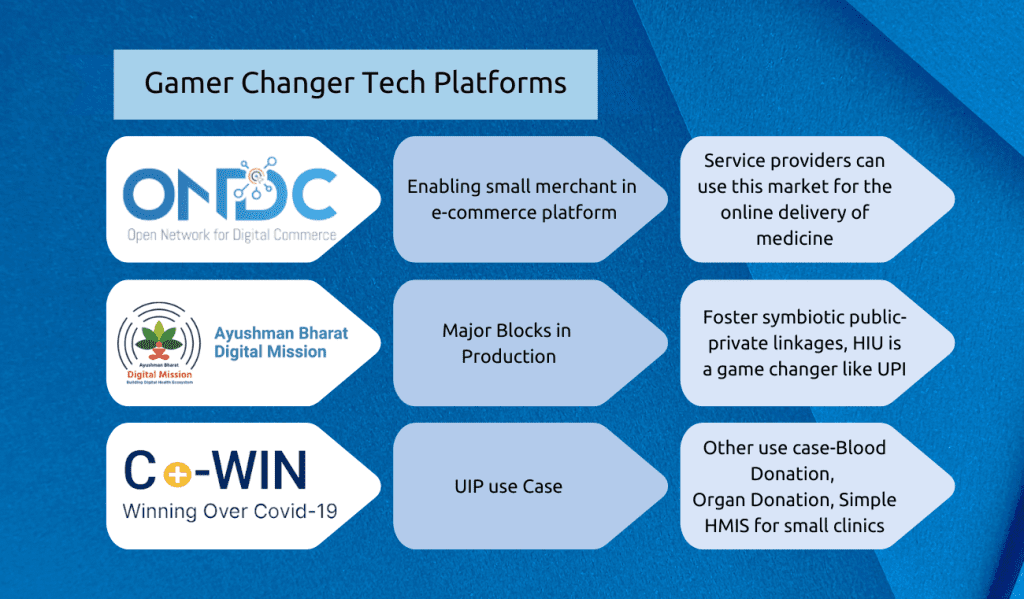Scaling Technology – Building on COVID
Read the Magazine in PDF
The COVID-19 pandemic has highlighted the significance of technology in healthcare during crises. We must continue enhancing these technologies to aid healthcare providers and provide the best patient care. By leveraging data, analytics, and innovation, we can establish an efficient, effective, and accessible healthcare system.
By - Mr Milan Narendra
Abstract
The article discusses the importance of technology in healthcare, particularly during times of crisis, such as the COVID-19 pandemic. The use of remote monitoring, digital consultations, and robots helped healthcare providers deliver care while reducing the risk of infection for medical staff. Going forward, technology will continue to enhance healthcare delivery through data analytics, innovation, and virtual care, resulting in more effective care and better patient outcomes. The integration of technology is transforming the way healthcare services are provided, with a focus on a seamless blend of physical and virtual healthcare delivery, putting the patient at the centre of the healthcare ecosystem. The article also highlights the integration of public and private sectors in healthcare, with a shared focus on improving patient care.
The Importance of Technology in Healthcare During Times of Crisis
Healthcare During Times of Crisis
The last couple of years has been a period of enormous difficulty and unpredictability for the world, with the COVID-19 pandemic causing numerous sectors to come to a halt and putting immense pressure on healthcare systems worldwide. In response to this crisis, technology emerged as a critical tool for delivering healthcare services, even in the most challenging of circumstances. One of the primary ways in which technology was utilized was through remote monitoring and digital consultations, which enabled healthcare providers to continue delivering care while reducing the risk of infection for medical staff. Robots were employed to carry out administrative tasks, as well as to deliver medication and food to patients. Technology was also used for contact tracing, screening, and diagnosis, with several countries demonstrating effective use of these tools, including South Korea, Taiwan, and Singapore. By utilizing these resources, healthcare providers were able to ensure that critical services were provided to those in need, even during the most difficult moments of the pandemic.
In the aftermath of the pandemic, technology is expected to remain a critical component of the healthcare industry. To achieve optimal business performance and drive growth, the collaboration between public and private sectors will be crucial, alongside the creation of new tools and technologies to support healthcare providers. Technology will enhance healthcare delivery by improving access and efficiency through data and analytics. With these tools, healthcare providers will be able to personalize their services, resulting in more effective care and better patient outcomes. Additionally, technology will enable healthcare services to expand beyond traditional provider networks by generating new and innovative services that can improve the health of individuals and communities worldwide.
Over the past two years, the importance of technology in healthcare during crises has become clear. Going forward, it’s crucial to continue improving these technologies to support healthcare providers and ensure optimal patient care. Through the use of data, analytics, and innovation, we can create a healthcare system that’s more accessible, efficient, and effective for all.
The healthcare industry is undergoing rapid changes, with technology integration playing a significant role in shaping its future. Smart health systems are blurring the line between physical and virtual healthcare, allowing for a seamless transition between the two. This shift is transforming the way healthcare is delivered and consumed.
The integration of virtual and physical healthcare has resulted in a significant development, which is the consolidation of both types of care. This means that patients can move between virtual consultations, physical examinations, and virtual follow-ups all within the same care journey. This blended model of care delivery is becoming more common, and it is anticipated to continue to evolve.
The primary focus of the smart health system is centred on providing a seamless and integrated healthcare experience for the patient. This is being made possible by the rapid advancements in technology and the increasing use of smart devices. For instance, wearable technology and lifestyle apps are increasingly becoming a part of our daily routine and are contributing to the establishment of a connected and smart healthcare ecosystem.
Furthermore, the healthcare industry is being reshaped by the application of data analytics and algorithms. The abundance of health-related data is providing healthcare providers with valuable insights into patient health, enabling them to make informed decisions about how to deliver care. As a result, new treatment pathways and more efficient methods of care delivery are being developed, leading to more effective treatments for patients.
The management of care delivery in healthcare is rapidly changing due to the increasing prevalence of virtual care, which is transforming the way healthcare services are provided. With the rise of telemedicine, patients can now access healthcare services remotely, without the need to travel to a healthcare facility. This has been especially beneficial during the COVID-19 pandemic when many patients were unable to access care due to travel restrictions. In addition to telemedicine, the integration of retail clinics and lab diagnostics into the healthcare ecosystem is an important aspect of the smart health system. Retail clinics are becoming more popular, providing patients with easy access to basic healthcare services. The integration of lab diagnostics is also improving patient care by enabling healthcare providers to make more informed decisions based on laboratory test results. The smart health system is also influencing the role of insurance in healthcare. Many insurance companies are now covering telemedicine services, making it easier for patients to access care without worrying about the cost. Finally, the integration of technology is transforming healthcare services in rural areas. Telemedicine is enabling patients in remote areas to access care from specialists, regardless of their location. This is improving access to care for millions of people who would otherwise have limited options.
The healthcare industry is being revolutionized by the integration of technology, leading to significant changes in the delivery and consumption of healthcare services. The focus of the smart health system is centred around the patient, providing a more integrated and seamless healthcare experience that will likely continue to improve with advancements in technology.

As part of this transformation, new organizational structures are being established to support the delivery of healthcare services, including command and control setups that are being repurposed for public health programs and disease prediction. The government and private sector are working together to ensure the success of this new system.
The successful rollout of the vaccination program has been a major milestone in this journey, and the government is now exploring ways to improve immunization records and track other important healthcare metrics. A platform is being developed to support the immunization program, as well as blood and organ donation, with the potential to have a significant impact on healthcare delivery in the country.
The integration of the public and private sectors in healthcare is driving a transformation in the industry, with a shared focus on improving patient care. Technology is a key enabler of this transformation, with a growing emphasis on a seamless blend of physical and virtual healthcare delivery. The goal is to put the patient at the centre of the healthcare ecosystem and leverage technology, analytics, and data to enhance the quality and accessibility of care. This includes improvements in the immunization program, blood donations, and organ donations, making healthcare more accessible and affordable to all. Ultimately, technology is a crucial component in the drive to improve patient outcomes, increase efficiency, and reduce costs in healthcare.
The evaluation of healthcare infrastructure is a critical element in the provision of high-quality healthcare services, and hospitals must have the necessary resources to provide optimal care for their patients. One way to achieve this is through the use of technology in supporting the healthcare system. Several Indian states, including West Bengal, Rajasthan, and Uttar Pradesh, are leading the way in adopting technology to improve the patient experience, especially in the private healthcare sector where early adoption can result in improved efficiency and better patient outcomes. In the current healthcare system, patients usually have custody of their health records, and they can choose to share their data with other healthcare providers. This is particularly important in the context of technology as it enables healthcare providers to access a patient’s health information with their consent, resulting in improved patient outcomes and increased efficiency in the healthcare system.
Compliance with CBD Regulations
Compliance with regulations regarding the collection, storage, and use of patient health data is crucial in the use of technology in healthcare. The Central Board of Direct Taxes (CBD) is the regulatory body responsible for overseeing these activities in India. To ensure compliance, healthcare providers must meet three important milestones.
- The first milestone involves the creation of unique identification numbers for patients that can be recognized by different systems and providers. This will allow for the seamless sharing of data with patient consent.
- The second milestone is the ability of healthcare providers to send patient data to other providers as needed.
- The third and final milestone involves the ability of healthcare providers to receive data from other providers, even if the patient has changed healthcare providers in the interim.
The healthcare industry is being transformed through the use of technology, which offers benefits such as increased efficiency, cost reduction, and improved patient experiences. Healthcare providers must comply with CBD regulations to ensure the proper use of patient health data. The three key milestones, including generating unique patient identification numbers, sending and receiving patient data between providers, and ensuring the continuity of patient data even if they change providers, are important in achieving compliance. Technology has the power to revolutionize the healthcare ecosystem, providing benefits for patients and providers alike.
Conclusions
Overall, the article highlights the importance of technology in healthcare during times of crisis, with the COVID-19 pandemic being a prime example. Technology played a critical role in delivering healthcare services through remote monitoring, digital consultations, and contact tracing. The integration of virtual and physical healthcare is reshaping the way healthcare is delivered and consumed, and the primary focus is centred on providing a seamless and integrated healthcare experience for the patient. The healthcare industry is being revolutionized by the integration of technology, leading to significant changes in the delivery and consumption of healthcare services, and new organizational structures are being established to support the delivery of healthcare services, with the government and private sector working together to ensure the success of this new system.




